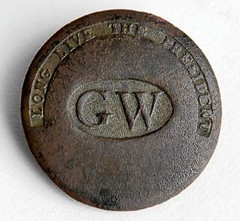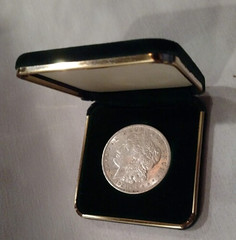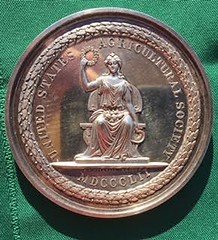
PREV ARTICLE
NEXT ARTICLE
FULL ISSUE
PREV FULL ISSUE
NOTES FROM E-SYLUM READERS: JULY 29, 2018 Reader Becomes Member I wanted to let you know how much I enjoy The E-Sylum. It is ALWAYS a great read, and it actually inspired me to join NBS. I've made some great additions to my library based upon articles in The E-Sylum and The Asylum, and I am putting up an exhibit at the ANA next month which itself was directly inspired by what I've learned through my membership in NBS, and it includes some of the books I've acquired due to E-Sylum and The Asylum. So thank you for all that.
Glad to help! Welcome to NBS. -Editor On the Value of Washington Inaugural Buttons
Also, the value quoted of $7500 each is ridiculous. I presently have a beautiful example for sale at under $5000. The value of an average "nice" condition dug piece is more like $1500. Finally, the comment that one of these buttons would cost six months salary for an average person back in 1789 is patently silly. An unskilled laborer averaged around 40 cents a day, say $125-150 a year. Skilled labor and artisans made double that amount, and teachers were in the range of $400 a year. While I don't know the cost of one of these buttons at the time, I would guess that they were no more than a dollar or two.
I don't follow the market for these, but the other two items stuck out for me, too. Only if the Dept. of the Interior in turn contacted a knowledgeable dealer would they be able to provide a meaningful answer, and a year's salary for a button is crazy. I don't know where they got that from. Articles on numismatic items in general newspapers almost always manage to mangle the facts, but they're still great for helping to spread interest in numismatics. -Editor Alan Weinberg adds: I agree totally with Rex's comments on the value of these GW Inaugural buttons. They are actually quite common with multi-hundreds known. They often come up for sale or auction. There are also highly deceptive spark erosion-produced forgeries known. Even the experts can be momentarily fooled. I was one.
To read the earlier E-Sylum article, see:
Answer: San Francisco Committee of Vigilance Medal 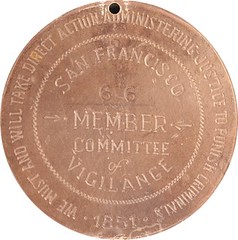

Regarding the piece a Newman Numismatic Portal user asked about, Rex Stark writes: Alan Weinberg and I discussed the engraved San Francisco Vigilance Committee medal, and we both agree that it's a worthless fantasy. Bill Hyder writes: The Vigilance Committee issued membership certificates in 1851, but no medals. The engraved 1851 medals are fantasies and have been around for some time now. Engraved gold medals were made for San Francisco alderman and one of these is on the Newman site. Michael Wehner (an avid collector of the 1856 medals) and I have an article slated for the December issue of The Numismatist that deals in part with the Committee of Vigilance medal and an 1861 Civil War political medal issued in San Francisco.
Thanks, everyone. Here's the gold medal Bill mentioned. It's a "City of San Francisco to Morgan L Mott, Alderman - Gold Nugget Medal" from the Alan Weinberg collection. -Editor
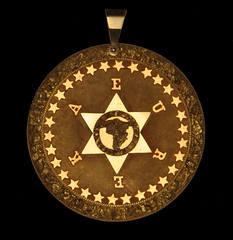
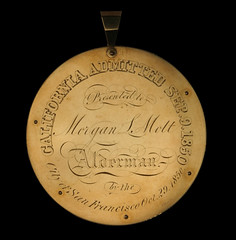
To view the medal images on the Newman Numismatic Portal, see:
To read the earlier E-Sylum article, see:
The John S. Davenport Library Reports on the demise of the John S. Davenport library have been greatly exaggerated. While some of his books kept in an outside storage shed did perish, many others survived in excellent condition and were sold in Kolbe Sale 87, March 22, 2002. Comprising lots 767 to 1070, the consignment was billed as “The John S. Davenport Library & Numismatic Research Archives.” Many featured Dr. Davenport’s bookplate and a number were inscribed to him and/or were signed by him. Highlights included a set of Brause-Mansfeld’s classic work on siege coins; Lyman Low’s interleaved and annotated 1878 Fonrobert collection catalogue of South American coins and medals; Madai’s famous 1765–1774 “Thaler Cabinet”; a set of Tentzel on “Saxonia Numismatica”; and numerous other 18th and 19th century classics. Over two dozen numismatic publications written by and belonging to Davenport were featured in the library. A number were interleaved, many were extra-illustrated by Davenport, and a goodly number were greatly enhanced by his annotations. Additionally, Davenport’s photographic archives were sold as a single lot, comprised of “tens of thousands” of illustrations of European crowns and talers, and various other world coins.
Thanks. Libraries and collections evolve over time, changed constantly by acquisition and deacquisition. A snapshot in time rarely shows the complete picture. Do any of our readers own books with the Davenport Library bookplate? The lesson remains, though - Florida storage sheds without cooling or dehumidification are less than ideal homes for books. -Editor George Kolbe adds: In that vein, years ago I traveled to Tampa, Florida, to buy a library potentially worth tens of thousands of dollars. I bought barely enough to pay for the trip, and a number of the books I purchased only marginally passed the smell test. Most of the books had been subjected to extreme heat, humidity, and insects. It was depressing to see wonderful classic numismatic works mouldering away. In contrast, when I purchased the library of Thomas Faistauer in Cambuquira, Brazil, the books were kept in his temperature and humidity controlled home and were generally in excellent condition. The San Bernardino Mountains may be a bit off the beaten path but Crestline is an extremely good place for books.
To read earlier E-Sylum articles, see:
The Corio Gold Stater 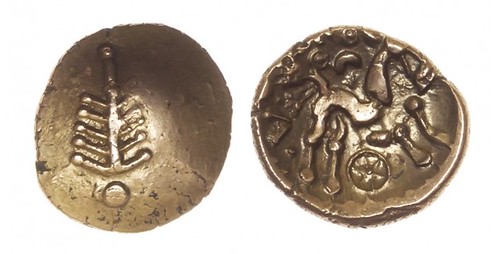
Last week this Corio Gold Stater from Baldwin's caught my eye. -Editor Bob Van Arsdell writes: I’ve written a dozen articles about the Semiotics of Celtic Coins in Britain. Several of the articles talk specifically about the Dobunnic emblem. It’s too easy to look at the abstract images and see anything you want to see - like looking at clouds and seeing bunnies. Celtic coins, as any others, carry crafted messages from rulers to the people. Expect complexity - the subject of interpretation requires an approach to match. All the articles are on my website (Homepage/Numismatic Articles on the vertical Navbar). They can also be found in the list of Semiotics articles in the catalog (Background/Semiotics on the horizontal Navbar). Although the articles are tailored to the British Celtic series, the underpinnings lie in the work of Umberto Eco. The principles involved are applicable to any kind of numismatic imagery. The Bibliography, now over 125 pages long, can be found in the catalog under (Appendices/Bibliography on the horizontal Navbar). It includes much of what has been written on the subject of British Celtic numismatics
Thanks! -Editor
To visit Bob's web site, see:
To read the earlier E-Sylum article, see:
The 1806 O-108 Half Dollar It was a treat to again see the 1806 O-108 half dollar in The E-Sylum. I was delighted when it came across my desk for attribution and grading by NGC, and I had it photographed prior to encapsulation. This rare coin is now a star at NGC's VarietyPlus website.
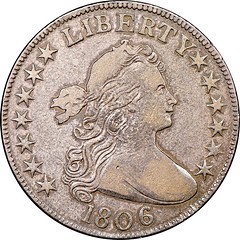
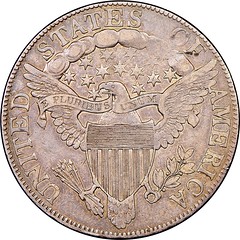
1806 KNOB 6 NO STEM O-108 50C MS
Diagnostics
Comments
Naturally, I like the un-slabed photos better. Thanks! -Editor
To view the coin on VarietyPlus, see:
To read the earlier E-Sylum article, see:
Morgan Dollars and Mint Display Boxes I have some of the Morgans housed in mint boxes, I will dig up some info. My recollection is the coins were on display at the Old San Francisco Mint, and when the display came down they sold the coins. There were a few hundred of them. The mint sent letters to some subscribers to see if they wanted them. I think this was in the mid-1990’s.
Interesting provenance if that connection can be documented. It doesn't mean the coins are particularly rare or special, but it's a good story. Why have a run-of-the-mill coin when you can have one that once was part of an exhibit? But without today's coin encapsulation there's no way to prove a boxed coin came from that source. Gene Brandenburg's piece was purchased at a Mint store in Washington, D.C., but it could have been supplied from San Francisco. -Editor
To read the earlier E-Sylum articles, see:
The Dunsmore Painting Mint Bicentennial Medal I like the description of the John Ward Dunsmore "Washington Inspecting" painting: "As history, however, the painting is pure bunk, depicting, as it does, a group of people who mostly never visited the Mint, attending a ceremony that never occurred, all set in a Mint building that did not exist in 1792." This historical inaccuracy didn't seem to bother the Mint too much as they used that work on the U.S. Mint Bicentennial Medal issued in 1992. I recently sold an example of this medal on eBay still in the sealed plastic protection; stuffed in the box of issue was the Mint press release concerning this medal.
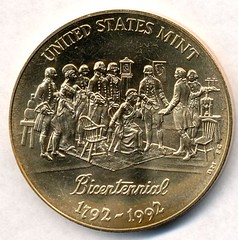
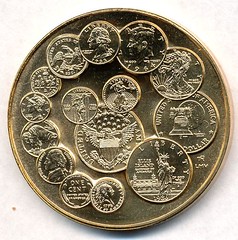

Dunsmore: Washington Inspecting the First Money Coined by the United States
Thanks. This arrived from Dick back on July 10, but got buried in my inbox for a while. Sorry. -Editor
To read the earlier E-Sylum article, see:
United States Agricultural Society History
I poked around, and learned that the Society was indeed quite influential. There is a 1937 Agricultural History article titled, The United States Agricultural Society, 1852-1860: Its Relation to the Origin of the United States Department of Agriculture and the Land Grant Colleges. Wikipedia has some information, too. -Editor From Wikipedia: The United States Agricultural Society was founded during a convention. Twelve different states in the country had agricultural societies. They decided to become one unit, creating the USAS. It was the started at time when there was no Department of Agriculture in the United States government, before Abraham Lincoln established an independent Department of Agriculture... The Society held its annual meeting in Washington DC and held exhibitions in other cities in the United States. It was powerful body with the ability to influence Congress and was able to influence the Congress to bring in enactments the Land Grants Act and creation of Department of Agriculture in 1862 can be attributed to it. To read the Wikipedia article, see: United States Agricultural Society (https://en.wikipedia.org/wiki/United_States_Agricultural_Society) For more on the Agricultural History article, see: The United States Agricultural Society, 1852-1860: Its Relation to the Origin of the United States Department of Agriculture and the Land Grant Colleges (https://www.jstor.org/stable/3739485?seq=1#page_scan_tab_contents)
To read the earlier E-Sylum article, see:
Flavors of the U.S. Mint Dick Johnson forwarded this Family Circus cartoon by U.S. Mail, and I scanned it for use here. Thanks. -Editor
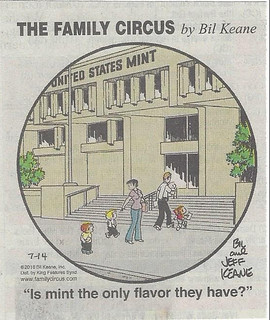
Eric Mead's Amazing Coin Magic Trick Tom Fort submitted this great coin trick video. Thanks! -Editor
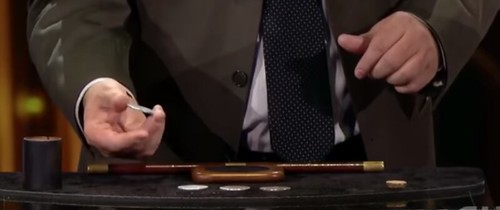
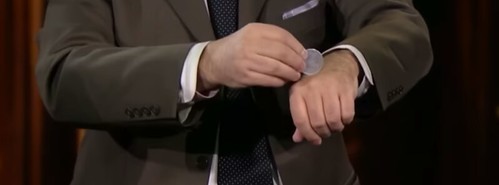
Eric Mead performs an amazing coin magic trick on Penn & Teller Fool Us. Does it fool them? I hope you enjoyed this great performance. Tom adds: I am not certain if one wants this magician coming into a coin show. Dealer stock could disappear and the crowd would love it:
To read the earlier E-Sylum article, see:
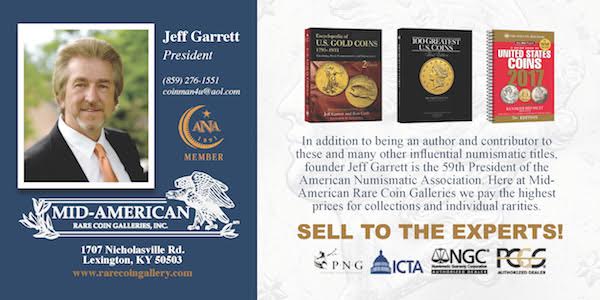
Wayne Homren, Editor The Numismatic Bibliomania Society is a non-profit organization promoting numismatic literature. See our web site at coinbooks.org. To submit items for publication in The E-Sylum, write to the Editor at this address: whomren@gmail.com To subscribe go to: https://my.binhost.com/lists/listinfo/esylum All Rights Reserved. NBS Home Page Contact the NBS webmaster 
|
